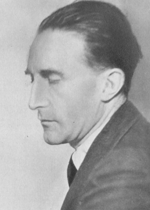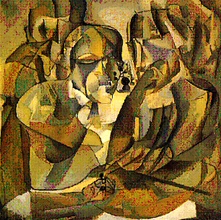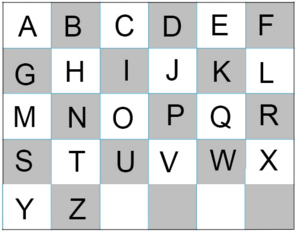Duchamp Marcel (28.07.1887 – 01.10.1968)
 National French Master and one of the most famous artists of our time. Duchamp was the father of Dadaism and a pioneer of Surrealism. Art and chess were his two passion in life. As the Times critic wrote in 1966: “Duchamp’s passion for chess may be thought an expression of his dislike for the trappings that cover the purity of thought.” Among his works “Portrait of Chess Players” is one of the most interesting. This is an oil canvas painted in 1911. This picture depicts the process of playing chess better than many others of representational paining. Duchamp continued to paint in the most original fashion, setting the style for his contemporaries and followers. During the period from 1915 till 1923 he was occupied with the picture “Large Glass” or “The Bride Stripped Bare by her Bachelors Even”. Then he stopped painting and concentrated on chess. He played in the World Amateur Championship of 1924, four French Championships from 1924 to 1933, and four Olympiads. He played for the fourth board for France in the Hamburg International Team tournament in 1930. He won one, lost eight, and drew six. Duchamp also played in several minor tournaments, notable sharing first prize with Halberstadt and J.J. O’Hanlon at Hyeres 1928 and winning the championship of Paris in 1932. Together with Halberstadt he wrote ‘L’Opposition et les cases conjuguees sont reconciliйes’ (1932), published in a limited edition of 1.000 copies. Duchamp got married in 1927. Man Ray wrote of his marriage: “Duchamp spent most of the one week they lived together studying chess problems, and his bride, in desperate retaliation, got up one night when he was asleep and glued the chess pieces to the board. They were divorced three months later.”
National French Master and one of the most famous artists of our time. Duchamp was the father of Dadaism and a pioneer of Surrealism. Art and chess were his two passion in life. As the Times critic wrote in 1966: “Duchamp’s passion for chess may be thought an expression of his dislike for the trappings that cover the purity of thought.” Among his works “Portrait of Chess Players” is one of the most interesting. This is an oil canvas painted in 1911. This picture depicts the process of playing chess better than many others of representational paining. Duchamp continued to paint in the most original fashion, setting the style for his contemporaries and followers. During the period from 1915 till 1923 he was occupied with the picture “Large Glass” or “The Bride Stripped Bare by her Bachelors Even”. Then he stopped painting and concentrated on chess. He played in the World Amateur Championship of 1924, four French Championships from 1924 to 1933, and four Olympiads. He played for the fourth board for France in the Hamburg International Team tournament in 1930. He won one, lost eight, and drew six. Duchamp also played in several minor tournaments, notable sharing first prize with Halberstadt and J.J. O’Hanlon at Hyeres 1928 and winning the championship of Paris in 1932. Together with Halberstadt he wrote ‘L’Opposition et les cases conjuguees sont reconciliйes’ (1932), published in a limited edition of 1.000 copies. Duchamp got married in 1927. Man Ray wrote of his marriage: “Duchamp spent most of the one week they lived together studying chess problems, and his bride, in desperate retaliation, got up one night when he was asleep and glued the chess pieces to the board. They were divorced three months later.”

Duchamp used chess themes in several paintings and being the most highly esteemed artist to play chess at master level his comments on the game are of interst: “Chess is a sport. A violent sport. This detracts from its most artistic connections. One intriguing aspect of the game that does not imply artistic connotations is the geometrical patterns and variations of the actual set-up pieces in the combinative, tactical, strategical and positional sense. It is sad means of expression though – it is not very gay. If it is anything. it is a struggle.” He died in New York at the age of 81 after returning from England where he had a retrospective exhibition at the Tate Gallery in London.



